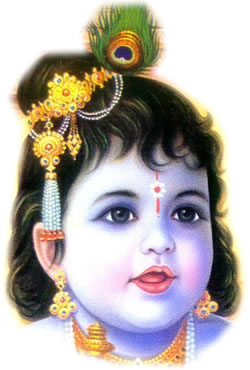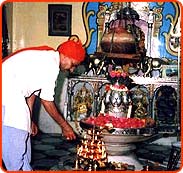





It has been believed that there is no evidence to determine the dates of events in the Ramayanic era. Some historians of the past even refuse to acknowledge that Rama and other characters from the Ramayana even existed. However, Sage Valmiki has recorded the dates if events in detail, albeit by describing the positions of stars and planets. To decipher the astronomical encodings has not been a trivial task, and not many have attempted to do so. It should be noted that the ancient Indians had a prefect method of time measurement. They recorded the 'tithis', days according to the nakshatra on which the moon prevailed, the months, the seasons and even the different Solstices. By therefore noting a particular arrangement of the astronomical bodies, which occur once in many thousand years, the dates of the events can be calculated. The correct astronomical records goes to show that Valmiki's has chronicled an account of a true story and also, that the an advanced time measurement system was known to the Hindus (Indians) atleast 9000 years ago.Before coming to the astronomical method, it should be noted that the Mahabharat has recorded a number of facts about Ramayan (and not otherwise).The precedence of the Ramayanic era to that of the Mahabharat can therefore be inferred. An attempt to fix the dates of the events in the Mahabharat era, mainly based on internal astronomical records





Astronomical Dating
Mahabharat states that Sage Vishwamitra started counting nakshatras from Shravana (Aadiparva A.71 and Ashwamedha A.44) and a new reference to time measurement thus initiated. According to the old tradition, the first place was assigned to the nakshatra prevelant on the Vernal Equinox. Vishwamitra modified this and started measuring from the nakshatra at the Autumnal Equinox. Sharvan was at this juncture at about 7500 B.C, which is therefore the probable period when Vishwamitra existed and also that of the Ramayanic Era.Formerly, the year initiated with the Varsha-Rutu (season) and therefore was termed "Varsha". Ramayan shows that the flag was being hoisted to celebrate the new year on Ashwin Paurnima (Kishkindha 16/37, Ayodhya 74/36). Ayodhya 77 mentions that the flags were defaced and damaged due to heat and showers. These descriptions point to the fact that their new year started on the Summer Solstice when heat and rain simultaneously exist. The Summer Solstice fell on Ashwin Full Moon, so the Sun was diagonally opposite at Swati nakshatra. This astral configuration can be calculated to have occured around 7400 B.C. Kishkindha 26-13 describes the commencement of the rainy season. In shloka 14, refers to Shravan as "Varshika Poorva Masa". Kishkindha 28/2 clearly shows that the rainy season began in Bhadrapada Masa. Further description "Heated by the Sun and showered by new waters, the earth is expelling vapours" (Kish.26/7) points to Bhadrapada as premonsoon. Kish.28/17 tells that there was alternate sun-shine and shadowing by the clouds. Kish.28/14 describes the on-coming rainy season. Thus Bhadrapada was the month of pre-monsoon, that is before 21st June or Summer Solstice. Naturally, months of Ashwin and Kartika formed the rainy season. It is therefore concluded that Ashwin Full Moon coincided with Summer Solstice, that year being 7400 B.C. Rama started forest-exile in Chaitra and ended it in Chaitra. He was coronated in the same month and one month later, proceeded to Ashokavan with Seeta (Uttar 41/18) when the Shishira Rutu terminated. So it seems that Vaishakha Masa coincided with Shishira. So the Winter Solstice was at Vaishakha with the Sun at Ashwini. At present, the Winter Solstice takes place at Moola. Thus a shift of 10 nakshatras has occured since the Ramayanic Era. Precession has a rate of 960 years per nakshatra. Therefore, Ramayan must have occured 9600 years ago, which is 7600 B.C approximately.
Shri Rama's Date of Birth
Now we shall proceed with the astral route. Valmiki records the birth of Rama as Chaitra Shuddha Navami (9th), on Punarvasu Nakshatra and five plants were exalted then; Sun in Mesha upto 10 deg., Mars in Capricorn at 28 deg., Jupiter in Cancer at 5 deg., Venus in Pisces at 27 deg. and Saturn in Libra at 20 deg. (Bala Kanda.18/Shloka 8,9). Ayodhya 4/18 states that Sun, Mars and Rahu were at Dasharatha's nakshatra. It was the month of Chaitra, so the Sun was in Revati, Ashwini or Bharani. Naturally, either Rahu and Ketu was in any one of these nakshatra (Rahu and Ketu are diagonally opposite). The planetary positions on 16th October 5561 B.C., the date of commencement of the Mahabharat War, have been calculated and known [Dating of the Mahabharat, by Dr. P.V. Vartak]. Therefore, calculating further backwards for the astral combination noted above, the date concludes to be 4th December 7323 B.C. On this date, Saturn was at 205 deg., Jupiter at 94 deg., Mars between 283 and 298 deg., Rahu at 179 deg. and Sun at 2 degrees. 4th Dec. 7323 therefore is the date of birth of Rama, when the aforementioned 4 planets exalted. Venus is always within 47 degrees from the Sun, and might be in Pisces in an exalted state. Thus Rama's date is confirmed.
The Date of Exile
Rama completed 17 years of age (Ayodhya 20/45) and his coronation was fixed on Chaitra Shuddha 9th on Pushya day. However, he had to proceed to the forest on the same day, at the behest of Kaikeyi. At this time, Dasharatha states that Rahu, Mars and Sun were disturbing his nakshatra (Ayodhya 4/18). Calculating 17 years from Rama's birth date, the location of Mars can be determined at 303 degrees in Dhanishta nakshatra. From here, Mars casts its fourth-sight on Krittika. Rahu, after 17 years had been at 211 degrees in Vishakha, and so was in opposition to Krittika. Being Chaitra masa, the Sun was at Mesha and so it could be at Krittika. This the planetary positions agree with Valmiki's statement. Dasharatha's nakshatra appears to be Krittika. Valmiki has beautifully described the sky (Ayodhya 41/10), when Rama left for forest exile. He states, "Crux (Trishankhu), Mars, Jupiter and Mercury have cornered the Moon. Vaishakha and Milky Way are shining in the sky". Crux is on line with Hasta (Corvus) on the southern side. On the eastern side of Hasta, there are Chitra, Swati and Vishakha. As seen earlier, Mars was at 303 deg. in Dhanishta. Calculations show that Jupiter was in Poorvashadha at 251 deg. Pushya was at the western horizon with the setting Moon. On the southern side, from the west to the east, all the other planets were situated. So poetically Valmiki describes the sketch as if the Moon was cornered by the planets. The description of the sky, 17 years after the birth-date of Rama, is perfect astronomically. After 14 years of Rama's stay in the forest, Valmiki tells that Rohini was imprisoned (6-24-7, 6-93-60, 6-92-60), Mars marched on Rohini (6- 93-46 or 6-92-45) and mars was torturing Rohini (5-17-24 or 5-15-22, 5-19-9, 6-113 or 116-2). The bracketed seven statements show the vicinity of Mars with Rohini. Calculations reveal that 14 years later, Mars was at Ardra and was retrograde. Mars therefore moved in the reverse direction (from Ardra) to Rohini, resided at the "gate" of Rohini, thus in a way imprisoning the latter. It is to be noted that the constellation of Rohini is V-shaped. The apex of the angle points to the west and the two limbs towards east, and therefore appears like a "gate". Mars was situated in between the two limbs (or two doors) of the gate and appeared like a guard. Thus can the simile be explained. Amavasya (No Moon Day)comes 10.883 days earlier each successive year. 25th November 7323 B.C., 9 days before Rama's birth, was a Amavasya. In 17 years, the Amavasya shifted by 185.011 days backwards. It means that 6 Amavasyas (each 29.53 days) were completed and a shift of 7.8 deg. was noticed. The original Amavasya before Rama's birth took place at 353 deg. Deducting 7.8 deg. from it, we obtain 345 deg. as the position of this Amavasya which falls in the Uttara Bhadrapada nakshatra. Naturally, the next month was Chaitra, when the coronation was arranged on Pushya day at 104 degrees. One 'tithi' contains 12 degrees. So the moon was in Pushya on 29th November 7306 B.C., when Rama proceeded to the forest. Calculations show that this day was a Thursday, so said by Seeta as well(Ayodhya 26/9). Rama left for the forest on a Thursday, the 29th Nov. 7306 B.C. He completed the required 14 year period in the forest and returned on 5th Shuddha 9th was over, and the 5th tithi refered to must have been Chaitra Krishna 5th. Amavasya recedes by 10.883 days each successive year. So in 14 years it must have receded by 152.3 days. Deducting 5 Amavasya periods (29.53 days each), 4.7 days remain which implies that Amavasya came 4 days days earlier on 15th November 7292 B.C. Calculating backwards for 14 years from 29th November 7306 B.C, when the Amavasya was at 345 deg., the Amavasya falls at 340 deg. (receded by 4.7 days in 14 years). This is Uttara Bhadrapada, the month being Phalguna. Since the next month was Chaitra, Krishna 5th tithi happens to be 5th December 7292 B.C. when Rama entered Bharadwaja Ashram.
Hanuman's visit to Lanka
Hanuman set out to Lanka in the hopes and mission to search for the kidnapped Seeta. He reached this destination at night, roamed around a little until he located Seeta the next morning. While describing Hanuman's return in Sunder Kanda (S.56 or 57 /1/2), Valmiki states using a simile of sea to the sky: " The Moon was attractive like a lotus, Sun like a good crane and a span from Pushya to Shravana was seen. Punarvasu appeared like a big fish, Mars like a crocodile, Airavata like an island and Swati like a swan." Even though a poetic simile, Valmiki provides a plot of the nakshatras from the west to the east. When Hanuman started from Lanka it was early morning, because Seeta tells him to rest for a day in some hiding place (Sunder 56/3,11; 57/18). Since it was morning, the Sun was rising and appeared like a crane and the moon like a lotus. As both the moon and the sun were present simultaneously in the sky, it probably was a Paurnima (Full Moon Day) with the moon on the western horizon and sun on the eastern. The span of nakshatras streched from Pushya to Shravan, that is from 104 deg. to 281 deg. Punarvasu was also seen. Aairavat connotes an elephant, and it is possible that Scorpio was seen like an elephant showing its trunk. The span of nakshatra's from Punarvasu to Sharavan is seen early in the morning of Krishna paksha of Pushya Lunar month. Sun-rise could also be seen. Hence, most probably, Hanuman returned from Lanka of Pushya Paurnima or Pushya Vadya paksha.
The Great War started
On Phalgun Krishna 2nd, Rama's army seiged the gates of Lanka. Angada proceeded as Rama emmisary on a peace mission to Ravana's court. However, any peace proposal was rejected by Ravana and the next day (Phal.Kr. 3rd), Rama-Ravana war commenced. The great war spanned 13 days and concluded on Phalgun Krishna Amavasya, with the death of Ravana. The very next day, Chaitra Shuddha 1st was celebrated as a Victory Day. This tradition still continues to be a New-Years's Day and is marked by hoisting flags. End of Rama-Ravana War. Ravana killed. 15th November 7292 B.C was then Phalguna Amavasya. Valmiki states that Ravan came out for the last battle on the Amavasya day (Yudh. 93/66) and was killed. In the description of the battle, Sage Valmiki writes, "Kosala's nakshatra Vishakha is aspected by Mars" (Yudh. 103/37). The annual motion of Mars is 191.405 degrees. In 14 years, it will progress by 159.58 degrees. At the time of Rama's exile, Mars was at 303 deg. 159 deg. added to this provides Mars at 102 deg. in Pushya. From Pushya Mars could cast its fourth-sight on Vishakha. So, the calculations presented so far seem to be correct. It also shows Valimiki's minute observations and time recording capabilities. Thus the date of the last battle of the War is 15th November 7292 B.C.
Following are the dates of few events from the Ramayana:
Rama's Birth Date
4th December 7323 B.C
Rama-Seeta Married
7th April 7307 B.C
Rama Exiled
29th November 7306 B.C.
Hanuman enters Lanka 1st September 7292 B.C
Hanuman meets Seeta 2nd September 7292 B.C.
Seetu (Bridge) built 26-30th Oct. 7292 B.C
on the ocean
The War begins
3rd November 7292 B.C
Kumbhakarna is killed
7th November 7292 B.C.
Ravana is killed by Rama
15th November 7292 B.C.
Rama returns to Ayodhya
6th December 7272 B.C.
References
Dr.P.V.Vartak, Vastav Ramayan in Marathi, Vedvidnyana Mandal, Pune Ramayana and Beyondİ (on line book) Introduction - Introduction
Chapter 1 - Ramayana Story
Chapter 2 - Sri Rama and Sita, love and marriage in Ramayana
Chapter 3 - Ravana in Ramayana Story
Chapter 4 - Warfare in Ramayana Story
Chapter 5 - King Rama, Bhakti and Royalty in India
Introduction The present work is a commentary on the Ramayana story taking into account all versions of Ramayana particularly the original Ramayana written by Valmiki and the devotional version of Ramayana that being Ramacharitamanasa by the poet Tulsidasa. The story itself is about justice, bravery, love, the victory of forces of light over the forces of evil, the divine intervention on earth in order to put things right. This commentary emphasizes on the integration between the issues of Karma as pertinent to the very basis of Ramayana story, the story itself and its relevance today. The eternal law, Sanatana Dharma is a subject made dominant in conjunction with the determinism at the cosmic level. Thus Lord Vishnu descends on earth as Lord Rama on a setup scenario masterminded in heaven in order to reinforce Dharma and teach the people on earth a valuable divine lesson. The present commentary takes into account spiritual issues both at cosmic and earthly levels and their implications.This work develops systematically notions of cosmic Karma, a description of the story itself and the significance of the love story between Sri Rama and Sita. Subsequent chapters comment on forces of evil, the issues of warfare, ending up with topics of royalty, Bhakti and the relevance of Ramayana story in the present days India and a conclusion. This work of commentaries on the Ramayana story was inspired by the unusual events started to manifest in India at Rikhia, a small village in the Deoghar district, Jharkhand State. There resides Swami Satyananda Saraswati a Hindu sage who has received a divine inspiration to reenact the celebration of marriage of Sri Rama to Sita (Sita Kalyanam) during a couple of years in a row. This celebration managed to magnetize thousand of people from India and from all over the world, the chanting of Ramayana and all festivities purifying the hearts of people participants. This short work is just a humble attempt to present in the larger perspective of Hindu Dharma the whole of Ramayana story, from the point of view of a full-hearted participant to the events. Thus I hope that this commentary will achieve the purpose of creating a better understanding of the Ramayana story, its true message and the valuable lessons given to us for both the present and future times. May we all be blessed by Sri Rama and His story.

Ramayana stands along with Mahabharata as one of the two major epics in the Indian tradition. Accounts of timing of Ramayana assign the epic to be created before Mahabharata epic. From the epic itself arises the time of composition of Ramayana as being after the coronation of Rama that according to learned scholars was in the year 4400 BC. The epic composed by the sage Valmiki, who was a contemporary of the events described in Ramayana, is held to be of a great beauty regarding the Sanskrit wording of verses. The original base structure is consider to be of 12,000 verses later on growing to 24,000 verses, that is the present form of Ramayana as assigned to sage Valmiki. Most scholars consider the real Ramayana to be contained within the first 6 chapters, chapter 7 (Uttara Kanda) being added later. It can be easily observed that this last chapter does not really fit into the whole structure of Ramayana, events described do not have a continuation from the previous chapter. We have to assume that on accounts of being so ancient, Ramayana was subject to various interpolations that naturally occurred in such a long span of time since the original composition of sage Valmiki more than 6000 years ago. The work is largely seen as an allegory, in which various personages, human, demonic, animal or vegetation are sentient as the tradition of Hinduism is based on. Along with humans there are also monkeys (Vanaras), demons, bears, birds, etc. There are supernatural phenomena that do occur and involvement of traditional Hindu gods and goddesses is paramount. However, the whole of Ramayana cannot be understood unless the philosophical understanding behind the events have to be known.
As above, so below The Hindu thought is a complete integration of the events that happen at the cosmic level and those that happen on earth. The Indian thought developed the concept of cyclical time through the doctrine of 'Yuga' or cosmic ages. In this cosmogony there are vast time cycles of cosmic creation (Sarga) and cosmic dissolution (Pralaya) repeated ad infinitum, the whole universe being seen as contained within Brahma, the Creator who lives for one hundred brahmic years. One Brahma dies then after a while a new Brahma emerges created by Lord Vishnu, the Supreme. Thus everything that exists within the universe can be explained as related to the three fundamental essences, i.e. space (Brahmanda), time (Kala) and causality (Karanatattva). All static and dynamic existence finds an explanation taking into account these three essences. In other words the matter itself being on the time arrow is both cause and effect of manifestations or vibrations. These issues have considerable implications, as manifestations or vibrations once emitted are able to penetrate into a large scale of levels of existence, thus from one powerful manifestation a range of implications on other spheres of existence occurred. When the human factor is taken into account, extraordinary deductions can be made, and the implications at the human level become astonishing. Events that do happen in space have a reflection of earth at every level including human. Astrology is based on similar grounds, the Hindu astrology known under the name Jyotish is a very elaborated method of calculating implications at the human or societal level of the important movements and events in the cosmic space. The idea behind these suppositions is that the determinism is more prevalent at the lower levels and the higher a level of existence is, the more independent becomes. In practical terms, a powerful cosmic event has important implications at the societal level on earth, and become more deterministic and difficult to avoid as the level of consciousness goes down. Humanity having a level of consciousness above one individual, whatever implications are at that level will be reflected in a more deterministic way at the individual human level. In other words the individual person will be simply dragged by the events, social revolutions, and any important happenings at a more advanced level. Less to say that the world of animals and plants and anything below the humans will be invariably dragged in a more powerful way. This gives world events a deterministic view. It is precisely on these accounts that the Hindu tradition bases the grand events of humanity, all events being subjects to the concept of cyclical time through the existence of cosmic ages. We humans are subject to involuntary anthropo-cosmic experiences. Various layers of vibrations that interpenetrate each other give certain effects and implications to the various levels of influence on the time arrow. Thus the cosmic cause will affect the earth existence first at the level of society, in so determining multiple chain reactions in the form of implications at the lower levels. It is on this cosmic basis that Ramayana story is constructed Chapter 6 - Conclusion
Introduction The present work is a commentary on the Ramayana story taking into account all versions of Ramayana particularly the original Ramayana written by Valmiki and the devotional version of Ramayana that being Ramacharitamanasa by the poet Tulsidasa. The story itself is about justice, bravery, love, the victory of forces of light over the forces of evil, the divine intervention on earth in order to put things right. This commentary emphasizes on the integration between the issues of Karma as pertinent to the very basis of Ramayana story, the story itself and its relevance today. The eternal law, Sanatana Dharma is a subject made dominant in conjunction with the determinism at the cosmic level. Thus Lord Vishnu descends on earth as Lord Rama on a setup scenario masterminded in heaven in order to reinforce Dharma and teach the people on earth a valuable divine lesson. The present commentary takes into account spiritual issues both at cosmic and earthly levels and their implications.This work develops systematically notions of cosmic Karma, a description of the story itself and the significance of the love story between Sri Rama and Sita. Subsequent chapters comment on forces of evil, the issues of warfare, ending up with topics of royalty, Bhakti and the relevance of Ramayana story in the present days India and a conclusion. This work of commentaries on the Ramayana story was inspired by the unusual events started to manifest in India at Rikhia, a small village in the Deoghar district, Jharkhand State. There resides Swami Satyananda Saraswati a Hindu sage who has received a divine inspiration to reenact the celebration of marriage of Sri Rama to Sita (Sita Kalyanam) during a couple of years in a row. This celebration managed to magnetize thousand of people from India and from all over the world, the chanting of Ramayana and all festivities purifying the hearts of people participants. This short work is just a humble attempt to present in the larger perspective of Hindu Dharma the whole of Ramayana story, from the point of view of a full-hearted participant to the events. Thus I hope that this commentary will achieve the purpose of creating a better understanding of the Ramayana story, its true message and the valuable lessons given to us for both the present and future times. May we all be blessed by Sri Rama and His story. Ramayana Story Introduction Ramayana stands along with Mahabharata as one of the two major epics in the Indian tradition. Accounts of timing of Ramayana assign the epic to be created before Mahabharata epic. From the epic itself arises the time of composition of Ramayana as being after the coronation of Rama that according to learned scholars was in the year 4400 BC. The epic composed by the sage Valmiki, who was a contemporary of the events described in Ramayana, is held to be of a great beauty regarding the Sanskrit wording of verses. The original base structure is consider to be of 12,000 verses later on growing to 24,000 verses, that is the present form of Ramayana as assigned to sage Valmiki. Most scholars consider the real Ramayana to be contained within the first 6 chapters, chapter 7 (Uttara Kanda) being added later. It can be easily observed that this last chapter does not really fit into the whole structure of Ramayana, events described do not have a continuation from the previous chapter. We have to assume that on accounts of being so ancient, Ramayana was subject to various interpolations that naturally occurred in such a long span of time since the original composition of sage Valmiki more than 6000 years ago. The work is largely seen as an allegory, in which various personages, human, demonic, animal or vegetation are sentient as the tradition of Hinduism is based on. Along with humans there are also monkeys (Vanaras), demons, bears, birds, etc. There are supernatural phenomena that do occur and involvement of traditional Hindu gods and goddesses is paramount. However, the whole of Ramayana cannot be understood unless the philosophical understanding behind the events have to be known. As above, so below The Hindu thought is a complete integration of the events that happen at the cosmic level and those that happen on earth. The Indian thought developed the concept of cyclical time through the doctrine of 'Yuga' or cosmic ages. In this cosmogony there are vast time cycles of cosmic creation (Sarga) and cosmic dissolution (Pralaya) repeated ad infinitum, the whole universe being seen as contained within Brahma, the Creator who lives for one hundred brahmic years. One Brahma dies then after a while a new Brahma emerges created by Lord Vishnu, the Supreme. Thus everything that exists within the universe can be explained as related to the three fundamental essences, i.e. space (Brahmanda), time (Kala) and causality (Karanatattva). All static and dynamic existence finds an explanation taking into account these three essences. In other words the matter itself being on the time arrow is both cause and effect of manifestations or vibrations. These issues have considerable implications, as manifestations or vibrations once emitted are able to penetrate into a large scale of levels of existence, thus from one powerful manifestation a range of implications on other spheres of existence occurred. When the human factor is taken into account, extraordinary deductions can be made, and the implications at the human level become astonishing. Events that do happen in space have a reflection of earth at every level including human. Astrology is based on similar grounds, the Hindu astrology known under the name Jyotish is a very elaborated method of calculating implications at the human or societal level of the important movements and events in the cosmic space. The idea behind these suppositions is that the determinism is more prevalent at the lower levels and the higher a level of existence is, the more independent becomes. In practical terms, a powerful cosmic event has important implications at the societal level on earth, and become more deterministic and difficult to avoid as the level of consciousness goes down. Humanity having a level of consciousness above one individual, whatever implications are at that level will be reflected in a more deterministic way at the individual human level. In other words the individual person will be simply dragged by the events, social revolutions, and any important happenings at a more advanced level. Less to say that the world of animals and plants and anything below the humans will be invariably dragged in a more powerful way. This gives world events a deterministic view. It is precisely on these accounts that the Hindu tradition bases the grand events of humanity, all events being subjects to the concept of cyclical time through the existence of cosmic ages. We humans are subject to involuntary anthropo-cosmic experiences. Various layers of vibrations that interpenetrate each other give certain effects and implications to the various levels of influence on the time arrow. Thus the cosmic cause will affect the earth existence first at the level of society, in so determining multiple chain reactions in the form of implications at the lower levels. It is on this cosmic basis that Ramayana story is constructed

